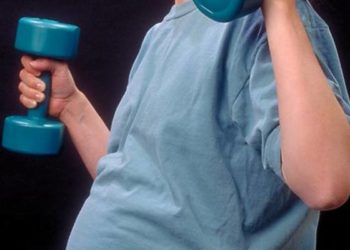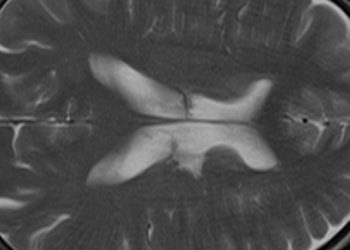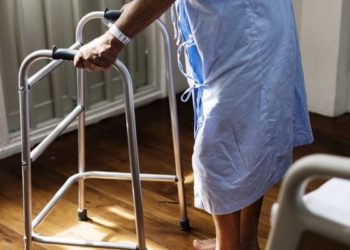2 Minute Medicine Rewind September 24, 2018
While dopamine dysregulation has been studied in relation to psychosis, there is limited information on the relationship between glutamate concentrations and psychotic symptoms. In this cohort study, investigators estimated anterior cingulate cortex glutamate concentrations in 28 individuals with a first presentation of psychosis and 28 healthy controls, in order to examine the correlation between anterior cingulate glutamate concentrations with striatal dopamine synthesis capacity as well as severity of psychotic symptoms. Anterior cingulate cortex glutamate concentrations were estimated using proton magnetic resonance spectroscopy (MRS), while striatal dopamine levels were estimated using 18F-DOPA photon-emission tomography (PET). Investigators found an inverse relationship between striatal dopamine synthesis capacity and anterior cingulate glutamate concentrations in patients with psychosis (p=0.03, R2=0.16) but not in the control group (p=0.39, R2=0.04). Glutamate concentrations were also predictive of striatal dopamine synthesis capacity in a model accounting for other variables such as age, gender, and ethnicity (p=0.015) and a model accounting for medication status (p=0.039). When investigators examined the association between cortical glutamate and psychotic symptoms, they found an inverse relationship (p=0.03, R2=0.16). This inverse correlation between glutamate concentrations and positive symptoms was strengthened by inclusion of age, gender, and ethnicity (p=0.0045) and remained significant even after accounting for medication use (p=0.0037). Investigators observed no significant relationships between negative symptom severity ratings and either glutamate or dopamine measures (p=0.09). Taken together, results from this study support that an inverse relationship between anterior cingulate cortex glutamate concentration and striatal dopamine synthesis capacity in individuals with first-episode psychosis, which has implications for research into possible therapeutics. This study was limited in that substance use before imaging was not confirmed or controlled for.
Association of Cannabinoid Administration With Experimental Pain in Healthy Adults
Although cannabinoids are commonly used in the management of chronic pain, its analgesic properties are not well understood. In this meta-analysis, investigators analyzed data from 18 placebo-controlled studies with a total of 442 participants to assess the effect of cannabinoid use on the experimental assessments of pain threshold, pain tolerance, pain intensity, pain unpleasantness, and mechanical hyperalgesia. Investigators found significant associations between cannabinoid administration and increased pain threshold (Hedges g of 0.186, 95% CI 0.054 to 0.318, p=0.006), reduction in pain unpleasantness (Hedges g of 0.288, 95% CI 0.104 to 0.472, p = 0.002), and increased pain tolerance (Hedges g of 0.225, 95% CI 0.015 to 0.436, p=0.04). In addition, investigators found that cannabinoid administration was not significantly associated with experimental pain intensity or mechanical hyperalgesia (p=0.81 and p=0.23, respectively). The improvement of pain tolerance, unpleasantness, and pain threshold suggests that cannabinoids may improve certain dimensions of pain but not others, which in turn may suggest differential effects on the affective dimension and the sensory dimension of pain. It is important to note, however, that this study was limited in that it only included data from studies of experimental pain; features of clinical pain may be different. Furthermore, studies included in this meta-analysis had their own limitations, such as difficulty blinding procedures in placebo-controlled studies due to the strong psychoactive effects of cannabinoids.
Evaluation of Clinical Outcomes of Sutureless vs Sutured Closure Techniques in Gastroschisis Repair
Sutureless repair of gastroschisis was introduced in 2004 and has been implemented in multiple centers, but there has been little conclusive evidence on outcomes in comparison to sutured repair. In this retrospective cohort study, investigators analyzed data from 97 patients who underwent gastroschisis repair in order to examine the effect of sutureless closure on mortality, length of hospital stay, and other markers of morbidity. Researchers found that the sutureless group had reduced antibiotic duration (mean days (SD) 7.2 (6.4) vs. 12.4 13.3, p=0.003), days intubated (mean days (SD) 2.8 (3.3) vs. 6.8 (1.3), p=0.001), and days requiring IV analgesia (mean days (SD) 4.2 (4.0) vs. 7.1 (4.5), p=0.003). Only 40% of the sutureless group required intubation in comparison to 100% of the patients in the sutured group. There were no significant differences between groups for length of hospital day (p=0.16), time to full enteral feeds (p=0.22), total parenteral nutrition (p=0.23), and duration of peripherally inserted central catheter (p=0.48). There were also no significant differences in overall rates of wound infection (p=0.81), positive blood cultures (p=0.29), total parenteral nutrition cholestasis (p=0.80), adhesions requiring operation (p>0.99), development of enterocolitis (p>0.99), inguinal hernia (p=0.8), and readmissions (p=0.36). The sutureless group did have a higher rate of subsequent umbilical hernias requiring operative correction than the sutured group (13% vs. 0%, p=0.02). Taken together, results of this study indicate that sutureless closure of gastroschisis is comparable to sutured closure and may improve certain outcomes, although there is a higher rate of umbilical hernia. This study was limited in that it only examined patients from one center where sutureless repairs were performed more recently than sutured repairs; multicenter randomized clinical trials are required to better establish the advantages of sutureless closure.
Cardiovascular Safety of Lorcaserin in Overweight or Obese Patients
The selective serotonin 2C receptor agonist lorcaserin has shown efficacy in modulating appetite and facilitating weight management in overweight or obese patients. The cardiovascular safety and efficacy of this compound, however, has not been well established. In this randomized controlled trial, investigators randomized 12,000 overweight or obese patients with atherosclerotic cardiovascular disease or cardiovascular risk factors to either placebo or lorcaserin in order to examine the effect of lorcaserin on major cardiovascular events. At 1 year of follow-up, investigators found that the lorcaserin group had a mean weight loss of 4.2 kg in comparison to 1.4 kg in the placebo group (p<0.001), with 38.7% of the lorcaserin group having weight loss of 5% compared to 17.4% of the placebo group (OR 3.01, 95% CI 2.74 to 3.30, p<0.001). In terms of cardiovascular risk factors, the lorcaserin group had slightly improved values for blood pressure, heart rate, glycemic control, and lipids in comparison to the placebo group. In terms of cardiovascular safety, 6.1% of the lorcaserin group had a major cardiovascular event in comparison to 6.2% in the placebo group (HR 0.99, 95% CI 0.85 to 1.14, p<0.001 for noninferiority). For extended major cardiovascular events, both groups had similar incidence rates (11.8% vs. 12.1%, HR 0.97, 95% CI 0.87 to 1.07, p=0.55 for superiority). No other significant between-group differences were observed for serious adverse events. Overall, results from this study indicate that lorcaserin holds efficacy in weight management without introducing significant cardiovascular risk, although this study only examined one dose of lorcaserin and did not include participants without existing cardiovascular disease or risk factors.
The immunotherapy dinutuximab, an anti-GD2 chimeric monoclonal antibody (mAb), has been used alone and in combination with interleukin-2 and granulocyte-macrophage stimulating factor (GM-CSF) as a treatment for high-risk neuroblastoma. Hu3F8, a humanized IgG1 subclass form of the murine IgG3 anti-GD2 mAB 358 (m3F8) has been shown to have a higher affinity for GD2 ganglioside than dinutuximab. The role of hu3F8 in conjunction with GM-CSF at high doses, without significant toxicity, however, has not been well studied. In this phase I cohort study, investigators administered hu358 and GM-CSF to 57 participants with resistant neuroblastoma in order to determine the maximum-tolerated dose of hu3F8. Dosages in this study were as high as 9.6 mg/kg/cycle, which is more than 2.5 times higher than the standard dosage of dinutuximab and m3F8; no maximum-tolerated dose was identified. In terms of toxic effects observed in 5% or more of patients, human antihuman antibody positivity developed in 9% of patients after the first cycle of administration. Investigators observed grade 1 and 2 common adverse effects of pain, urticarial, and cough. Grade 3 toxic effects affecting organs included transient elevations in liver enzymes for 10% of patients and development of mydriasis and abnormal accommodation in 9% of patients. Four patients (7%) experienced dose-limiting toxicity (DLT) during the study, with 1 patient experiencing DLT upon first infusion of hu3F8. For serum studies, investigators observed human antihuman antibody positivity in 9% of patients after the first cycle of hu3F8 administration. In terms of tumor effects, investigators found that 45% of participants had complete remission or partial response, 16% had stable disease for more than 5 months, and 35% had early progressive disease. Among patients enrolled with refractory disease, 30% of those treated with 4.8 mg/kg/cycle of hu3F8 and 79% of those treated with 5.4 mg/kg/cycle had major responses. Taken together, results from this study suggest that hu3F8 has an acceptable profile for toxic effects while providing some efficacy for resistant neuroblastoma. As this was a phase I trial with a small number of patients for each dose level, further studies are required with larger patient populations and further analysis of hu3F8 efficacy.
Image: PD
©2018 2 Minute Medicine, Inc. All rights reserved. No works may be reproduced without expressed written consent from 2 Minute Medicine, Inc. Inquire about licensing here. No article should be construed as medical advice and is not intended as such by the authors or by 2 Minute Medicine, Inc.







